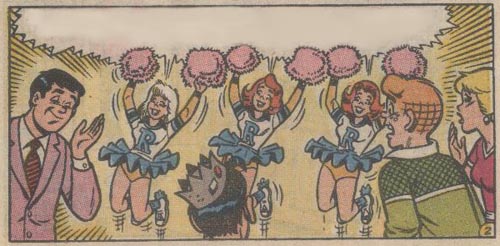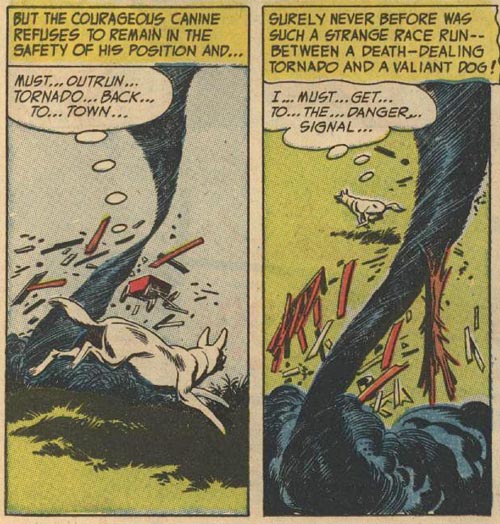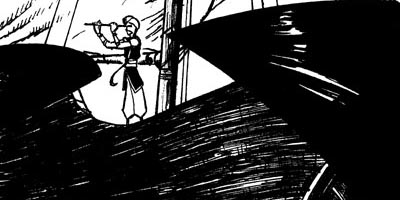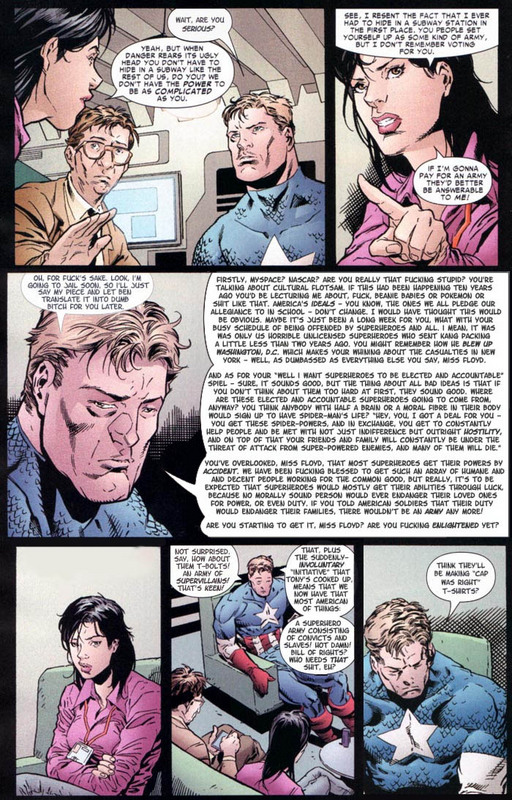I picked up IDW’s first Archie Comics collection, The Best of Dan DeCarlo Volume 1. Since no one has yet posted a list of the contents, I thought I’d have a go at it.
Before I do, I’ll give some brief thoughts: the biggest quibble is that there are only 26 stories here, and they barely scratch the surface of DeCarlo’s output in the years 1958-1969. It’s limited to Betty and Veronica stories (DeCarlo had that almost exclusively, but also contributed to many other titles), and while almost all of them are good, not all of them can really be called standouts. However, I’m assuming that the choice of stories was dictated in part by which stories had original art available. Many of these stories look lovely, especially the late ’50s/early ’60s material when DeCarlo was at his best, and a comparison with an old copy of one of the comics seems to suggest that they’ve done a good job of reproducing the original colours.
The most pleasing thing, as I said elsewhere, is that the table of contents includes credits for all the stories, which originally appeared uncredited. DeCarlo got to sign his name alongside Stan Lee’s when he was at Marvel, doing Millie the Model, but at Archie he never got credit for anything except a tiny “By Dan n’ Dick” credit on some of the Josie comics. (Dick being the editor, Richard Goldwater.) That restores credit not only for DeCarlo, but for his main inker, Rudy Lapick, for his brother Vince DeCarlo, who did most of the letters, and above all Frank Doyle, who is credited here with writing 23 of the 26 stories — and the story for which the credit reads “writer unknown” might also be a Doyle script.
I’ve always been a fan of Doyle ever since I read his credited work in the ’80s, but his earlier, uncredited work is even better; it’s his writing that really elevates the best of these stories. DeCarlo is excellent here, sexy and funny and smooth, though by the end of the volume you can see how his slickness and polish sort of settled into a “factory” style (the early stories have much livelier and funnier drawing). But his drawing for Archie wasn’t any better than his work for Timely/Marvel, and if you want to argue that Millie the Model represents his very best drawing, I wouldn’t really disagree. But though Stan Lee’s writing on the Marvel/Timely humor titles certainly wasn’t bad, Doyle’s best stuff is in a different league (from Lee’s humour comics, I said — I’m not talking about the action/superhero stuff), with simple yet smart dialogue that’s not on-the-nose awkward like most comic book dialogue, a storytelling style that favours observational humour over plot mechanics, and lots of visual opportunities for DeCarlo.
I’ve compared Doyle’s work to “Seinfeld” because, on a smaller scale, he has that ability to build stories around tiny details of social life and relationships, or the way people can get obsessed with petty things. (That’s why the stories sound pretty basic when I summarize them, but have a much stronger profile when you read them.) The definitive story in the book, “Snob Sister,” is just five pages of Veronica showing Betty the different ways in which people can be “snobbish.” It’s simple, it’s fun, and it just comes off as a little smarter and sharper than any of the Archie imitators of the era.
So yes, there are a bunch of stories I would have liked to see in this volume that aren’t there. And fans of “good girl” art may be a bit disappointed that there are so few beach stories. But if you’re not a buff on this kind of comic, it’s a reasonably-priced introduction to DeCarlo’s art and the “good” years of Archie comics in general. And the decision to include credits is, as I said, something that fills me with a lot of good will. IDW has further Archie collections planned, including Bob Montana’s newspaper strip — which is where the Archie “house style” was really created — and a “Best of Stan Goldberg” collection with Stan Lee writing the foreword (this volume doesn’t have a foreword). I hope this one sells enough to justify more artist-themed collections and, in time, perhaps more DeCarlo collections; we really need a collection of his best post-Marvel work, the early, funny, pre-Pussycats Josie.
Here then are the contents. All scripts are by Frank Doyle unless otherwise noted:
1. “Birth of a Notion” (Betty and Veronica # 37, July 1958) – The boys toss around a doll and fool the girls into thinking they’re tossing around a baby. (Script: Sy Reit)
2. “Flip Flopped” (Betty and Veronica # 38, September 1958) – Veronica signs up for the cheerleading squad.
3. “Sheep Skinned” (Betty and Veronica # 44, August 1959) – The boys accuse the girls of being “sheep” for following the latest fashions.
4. “A Choice Choice” (Betty and Veronica Annual # 8, 1960) – Archie has to break his date with Veronica to take his mother out on her birthday.
5. “Something to Remember” (Betty and Veronica # 63, March 1961) – Veronica is peeved because Archie can never remember what she wears.
6. “The Reader Knows Best” (Betty and Veronica # 63) – Archie tries to do the same task for both Betty and Veronica, while assuring the reader that he knows what he’s doing.
7. “The Bluest Angel” (Betty and Veronica # 63) – Betty feels guilty about exploiting a misunderstanding between Archie and Veronica.
8. “Gambler’s Luck” (Betty and Veronica # 65, May 1961) – The girls toss a coin to see who gets Archie.
9. “Snob Sister” (Betty and Veronica # 69, September 1961) – Veronica argues that everyone is a snob about something or other.
10. “Switchcraft” (Betty and Veronica # 69) – Veronica thanks Betty for taking Archie off her hands.
11. “The Original” (Betty and Veronica # 77, May 1962) – Veronica explains that she doesn’t wear real jewels in public. (Credit reads “Writer unknown,” though it might also be Doyle)
12. “Commercial Caper” (Betty and Veronica # 83, November 1962) – Betty blows up “Archie Loves Betty” balloons.
13. “Glad To Help” (Betty and Veronica # 86, February 1963) – Archie tries to use Betty to make Veronica jealous.
14. “Dear Diary” (Archie Giant Series # 23, September 1963) – Betty writes her version of the day’s events in her diary.
15. “Sugar Doll” (Betty and Veronica # 103, July 1964) – Veronica tries to make candy.
16. “Heat Wave” (Betty and Veronica # 106, October 1964) – Archie, Betty and Veronica spend a hot day squirting each other with hoses.
17. “Bully Girl” (Betty and Veronica # 106) – Veronica shows off her new martial arts skills by beating up everyone in sight.
18. “The Midas Mess” (Betty and Veronica # 112, April 1965) – Everything Betty touches turns to gold.
19. “Prize Package” (Betty and Veronica # 112) – Betty tells Archie he’s won a “most popular boy” contest.
20. “Message Center” (Betty and Veronica # 116, August 1965) – Betty sees a message on the bulletin board saying Miss Grundy wants to see her after school.
21. “The Phenomenon” (Betty and Veronica # 117, September 1965) – Betty and Archie discover that when Veronica stands on her head, her speech balloons are upside down.
22. “Rhyme Time” (Betty and Veronica # 119, November 1965) – The narrator re-introduces us to the Archie gang, in rhyme.
23. “Do No Evil” (reprinted in Archie Giant Series # 137, January 1966 — but from the look of it it’s clearly an earlier story, probably from 1960 or so) – After the girls accuse them of being slobs, Archie and Reggie try to get revenge.
24. “Feed Deed” (Betty and Veronica # 130, October 1966) – At the beach, Veronica tries to outdo Betty’s cooking. (Script: George Gladir)
25. “Wing It” (Betty and Veronica # 155, November 1968) – Betty impresses the boys with her great throwing arm.
26. “Drive To Distraction” (Betty and Veronica # 167, November 1969) – Archie uses a beach umbrella to give Veronica some shade in his car.





